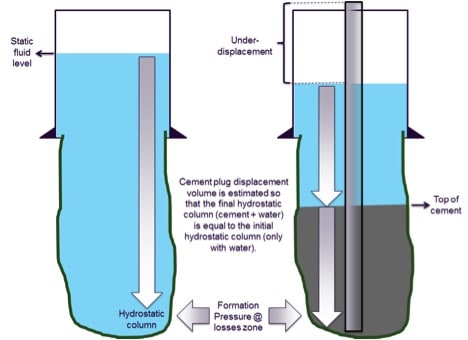Loss circulation challenges
This is a short article focusing on one topic: the balanced plug. During my time in Mexico, one of the main challenges That we faced was severe loss circulation. In new wells, due to the presence of fractured carbonates and low formation pressure (LPHT), several actions were usually in place. Examples include managed pressure cementing (cementing taking advantaged of MPD equipment/practices). Or the use of foamed or nitrified fluids and high-performance, lightweight cement.
In old wells, remedial cementing was particularly a challenge due to the inability of the wells to maintain the fluid level to the surface, even with water-like brines. I remember the sole task of abandoning an unnecessary perforated section or curing a casing leak required several operations. Time and time again several techniques formed part of our solutions repertoire, including nitrogen, nitrified fluids/gels, high-performance LCM, special cement systems, etc.
No balanced plug, but hydrostatic balance
The placing of cement plugs was particularly tricky and please forget about even mentioning the ‘balanced cement plug method’. As you can understand with the fluid level below surface (sometimes as deep as 3000m), there can’t be any balancing of the cement in the wellbore. Instead, I learned a practice developed locally called the ‘actual hydrostatic balance’.
In this plug-placement methodology, the wellbore hydrostatic column after cement placement equalizes the formation pressure at the losses zone. The practice required knowledge of the static fluid level before cementing (the point at which there were no losses) to be able to estimate the formation pressure at the losses zone; then acknowledging the losses occurring while cementing the cement is under-displaced to avoid putting more hydrostatic weight on top.
In other words, replacing control fluid by cement leading to a deeper fluid level after cementing allowing the cement to remain in the wellbore. Graphically the following picture describes this cement plug placement methodology.
For obvious reasons after the cement plug was placed and the working string was POOH slowly above the TOC, it was required to WOC sufficiently to allow the cement to develop at least sufficient gel strength before attempting to fill the hole.
There are other situations where a conventional balanced plug is difficult or impossible. This concept, even if simplistic, proved to be a great resource to increase the success rate of cement plugs in underbalance conditions.
If you have any comments or questions, please let me know in the dedicated space below
Cheers
Please take a look at some interesting ideas and comments related to curing losses here, on Spread. An excellent place of knowledge exchange in the industry.
L. Diaz




Hola Lenin,
Soy Carlos Hidalgo
Muy interesante tema del tapones realmente balanceados.
Saludos
Hola Carlos
Muchas gracias y un honor que te pasees por estas paginas
Saludos
L. Diaz
Hola Lenin, buen ejemplo de tus experiencias ademas sirve de ayuda para casos similares en otras regiones, ahora me queda una duda con respecto a la metodología “actual hydrostatic balance”, en los pozos donde no tienes circulación o retorno debido a las bajas presiones de formación como bien lo comentas es un reto hasta colocar un tapón balanceado, según la posición final de los fluidos que describes gráficamente, al finalizar el trabajo de colocar el tapón de cemento el nivel estático baja (para mantener PH de fondo final igual a la PH de fondo inicial) y así posicionas los volúmenes de cementos deseados en la profundidad deseada y es razonable por la teoría de suma de PH en fluidos in-miscibles, ahora bien, ¿operacionalmente como lo hacen? porque inicialmente debes desplazar y si no tienes retornos en superficie al final del bombeo de la lechada el nivel de fluido igual bajaría y si la formación toma libremente no se puede controlar la perdida de fluido en ese caso.
Hola Ismael
Básicamente sub-desplazas, es decir solo bombeas el volumen de desplazamiento según el calculo para mantener la PH. Ahora bien, este calculo es simplista, pues durante la caída libre dependiendo de la contribución de presión de fricción de la zona de perdida, puedes perder cemento adicional y a la final el tope de cemento va a estar por debajo del estimado en el calculo. Sin embargo, de igual forma, durante la misma caída libre vas a perder fluido de pozo adelante del cemento, lo cual, si consideramos también el cemento que pierdes, nos lleva a la conclusión que tu anular va a estar mas ligero que la predicción estrictamente hidrostática.
Sin embargo, todo eso es cierto, pero debemos recordar que esto es un tapón para curar perdidas, por lo cual el tope de cemento no es lo mas importante.
En conclusión, el objetivo de la técnica es disminuir la PH sobre el cemento al final del trabajo para asegurar que al menos algo de este cemento quede dentro de la zona de perdida o mejor todavía en el agujero.
Una consideración importante, es que el pozo no se debe llenar durante la espera por cemento, esto puede ser un riesgo en pozos donde existe la posibilidad de flujo de gas, fluido o incluso H2S.
Antes de utilizar la técnica debes discutir los riesgos con la compañía operadora y establecer un plan de mitigación y control para mantener la operación segura.
Saludos
L. Díaz
hello Lenin
Base for a cement plug (mechanical base, HIVIS, etc.)
· Pipe movement (rotation and reciprocation). What to do horizontal wells? What to do for vertical wells?
· Speed to POOH
· Reverse and direct circulation.. benefit for both cases
· Pump and pull cement jobs?
· Cement plug with plug catcher?
reason of using these practices
thank you
Hi John, thanks for your interest in proper well cementing.
Most of these practices might not applied in losses situation dpending of the rate of losses, some or most of the cement will be flowing to the losses zone while placement. A balanced cement plug is only possible if the well is under control and only then all our calculations and methods to reduce contamination appply.
Assuming the well is under control, I give you a quick summary:
. Base for a cement plug (mechanical base, HIVIS, etc.). To prevent sinking, particularly important in low density control fluids, kick off plugs, for example
· Pipe movement (rotation and reciprocation). What to do horizontal wells? What to do for vertical wells? In horizontal wells, the direction gravity is working does not allow density-driven balancing to occur. A possible method is the pump and pull.
· Speed to POOH. Always better slow, to prevent distrubing the cement, swabbing, etc.
· Reverse and direct circulation.. benefit for both cases. The only benefits for reverse circulation are reduce contamination to the mud (less treatment / disposal more relevant to WBM) and shorter circulation time, however the increase ECD may prevent its use in open hole situations.
· Pump and pull cement jobs? It is what you do in cement plugs with Coiled Tubing and in horizontal wells.
· Cement plug with plug catcher? Reduces the contamination during placement and while POOH, however contamination while POOH might worsen instead in smaller diamter well bores, due to swabbing.